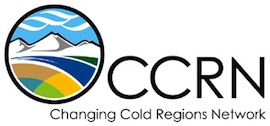
Dr. Masaki Hayashi
University of Calgary
Research areas
Our main research activities are hydrological process studies in three research areas representing the three eco-regions of CCRN, namely; Western Cordillera, Prairie, and Sub-Arctic Lowland. Our field-based process studies have a direct link with CCRN Theme B (Improved understanding and diagnosis of local-scale change) and also contribute significantly to Theme A (Observed Earth System change in cold regions).
In the Western Cordillera, our research focus is on groundwater storage and release mechanisms in the alpine headwaters, which is a major research gap in alpine hydrology world-wide. At the main research site, Lake O’Hara water, ecosystem, cryosphere, and climate (WECC) observatory, we continued with the long-term monitoring of hydrometeorological fluxes the key locations and prepared a comprehensive database of hydrological and meteorological data covering 2004-2017. The database will be archived in the CCRN data server and a manuscript describing the data set will be submitted to the CCRN special issue of the journal Earth System Sciences Data. In addition to our work at Lake O’Hara, we made progresses in collaborative work with John Pomeroy’s group at the Helen Creek watershed located in Banff National Park and the Bonsai Lake watershed located in the Fortress Ski Area in Kananaskis. The objective of these new studies is to examine whether the process understanding from Lake O’Hara is transferrable to other watersheds having different geological and topographic characteristics. At Helen Creek, we analyzed the data collected during 2014-2016 field seasons to understand the hydrogeological function of a rock glacier complex. We published one journal article and submitted another manuscript. At Bonsai Lake, we analyzed the data collected during 2015 and 2016 field seasons to investigate groundwater flow processes through a complex watershed consisting of talus slope, alpine meadow, and moraine deposits, which maintain steady flow at a headwater basin of the Kananaskis River. We have also started a new study in the same basin focusing on the interaction of groundwater with streams and its effects on stream temperature regime.
In the Prairie, our research focus is on groundwater recharge process and its response to climatic variability and landuse change, as well as the connection between groundwater recharge and discharge. At the main research site, West Nose Creek WECC observatory, we maintained the long-term monitoring of surface and groundwater processes. In addition to West Nose Creek, we initiated a new project in 2014 to understand the spatial and temporal variability of groundwater recharge in the Prairie using a funding from the Government of Alberta. We analyzed the data collected from West Nose Creek and two other instrumented study sites to show that groundwater recharge fluxes are sensitive to relatively small (ca. 20%) changes in precipitation along a west-east climatic gradient within the prairies. Our analysis indicated the importance of mid-winter melt events in influencing the amount of snowmelt runoff in spring.
In the Sub-Arctic Lowland, we continue collaborating with Bill Quinton’s group on the study of discontinuous permafrost at Scotty Creek WECC Observatory.
